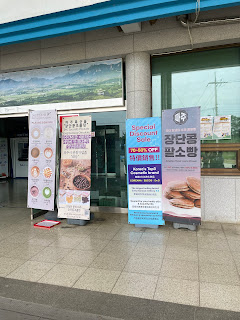In 1392, King Taejo founded the Joseon dynasty that ruled Korea for more than 500 years. During most of this time, the country remained isolated. King Taejo also invented the Korean alphabet. Before the Korean alphabet, Chinese was used. Interestingly, North Korea was using it since the 1950s while South Korea only adopted it in the 1990s.
Portrait of King Taejo in the Shrine of Felicitous Foundation in Jeonju
In the second half of the 19th centuries, Korea opened up to the outside world and particularly to the west. In 1910, the Japanese empire invaded Korea, demolished lots of old structures (buildings, palaces, etc). As Japan lost in World War II, Korea was divided in 1945 between US/ UN in the South and China and Russia in the North as the agricultural population was not seen as mature enough to rule themselves.
By 1950, north and south had established own governments and the leader of North Korea decided to invade the south. A three year war period followed that led to an armistice. Both countries remained close in their development for several years, the North showing even better growth for some time. From the 19x0s, they went on a different trajectory.
Fence at the DMZ
Checkpoint to enter the DMZ
In South Korea, several tour operators offer visits to the DMZ (Demilitarised Zone) which is two kilometres north and south of the boarder. At the time of my travel, visits to the Joint Security Area (JSA)at Panmunjom were suspended as in July 2023 an American soldier had crossed into North Korea during a tour. My tour started very early in Seoul (I was picked up at 6:30 in Itaewon).
By 7:30, we had reached Imjingak Park where a visitor centre informs about the Korean war times. Our guide took our passports and application list to get tickets from the government office - there was a run on the tickets as there seemed to be more demand than tickets. At 9, he got the tickets and the assigned time for the government bus.
I had booked a small tor with a visit to a suspension bridge as I thought it belonged to the DMZ. Instead the suspension bridge was only a tribute to South Koreans’ favourite pastime of hiking and has no historic connection. So feel free to skip it.
Suspension bridge
Tour highlights:
Imjingak Park
The visitor centre features several memorials to the Korean war, to reuniting families, to the girls that were enslaved by the Japanese as sex workers for the army. There is showcased a locomotive that has many bullet holes tand which was derailed in the Korean war, the freedom bridge over which prisoners of war were exchanged after the armistice. The park was built for South Koreans to commemorate their North Korean family members before the DMZ was opened.
More and more buses arrive
1950 locomtive with bullet holes
Freedom bridge
Peace Momunment for "Comfort Women"
3rd infiltration tunnel
So far, South Korea has discovered four tunnels that the North has built to infiltrate the South - they were discovered between 1975 and 1990. More are expected to have been drilled. Some of the four tunnels are open to the public on a DMZ Tour. I visited the third tunnel. Before you go down, you watch a video with a strong American voice talking about the history of the DMZ, the tunnels and the wildlife - it feels strongly like propaganda.
To go down, you have to store your bags and phone in a locker, walk through a security check and take a helmet. Then you walk down a steep ramp for 375 m (down the interception tunnel). At the bottom I saw a wall that was prepped for the dynamite to clear the next couple of meters. I then walked 265 m in direction to North Korea, where the third concrete blockade with a window to see the second blockade marks the closest point you can get to North Korea (170 m). For this tunnel, it’s really good to be small as the tall ones dinged quite a lot to the ceiling of the tunnel.
Ready to enter the tunnel
Dora Observatory
On the Dora mountain, is the observatory with binoculars directed at North Korea - I could see Chaeson Industrial Complex, Chaeson (city), propaganda village, fields, North Korean military post and radio towers from both side that should block signals from the opposing side. While I looked through the magnifying glass, I did not see any North Korean.
We are watching you!


















No comments:
Post a Comment